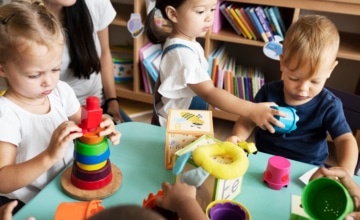Why Early Experiences Matter
What factors influence a child’s language development?
The seminal research that sought to answer this question was the Hart and Risley study (1995) which embarked on taping and transcribing the words spoke to—and around—children in 42 families, resulting in 2 ½ years of data from monthly one-hour observations. Hart and Risley’s research effort began when babies were 7-9 months old and continued until children were three years of age. Though the researchers acknowledge that all families nurtured their children and all children learned to talk and mastered the basic skills necessary for preschool entry, an analysis of the data found that children’s vocabularies at age three varied significantly and correlated with their families’ income levels—that is, children with the smallest vocabularies were members of families with the lowest incomes and vice versa. These differences in vocabulary were ascribed to vastly different language environments in their first three years of life in terms of: number of words spoken to and around the child; richness of language used in the home; use of questions and conversations with children; and other factors. The “Word Gap” has come to symbolize the inequities between very young children who have rich opportunities for positive early learning experiences and those who do not.
Re-examining the Science
Attempts to replicate the Hart & Risely study have had mixed results. In one example, researcher Dale Walker recruited 29 of the original 42 families for a follow-up study during the children’s third-grade year (age 9-10 years) and found that these early differences in vocabulary development predicted impacts well into the school-age period. Specifically, the rate of vocabulary growth at age three years was strongly associated with children’s receptive language and language development in third grade. Vocabulary use at age three years was predictive of both language skill and reading comprehension in third grade.
More recently, headlines have pointed to a study (Sperry et al., 2018) that challenge Hart & Risely’s claim. The authors used language data from five American communities and found significant variation in children’s language environments from one location to another within socioeconomic groups. The findings have renewed debate about the concept of a “word gap” and how this science is used for funding and program development. Roberta Michnick Golinkoff and other researchers in the field of language development take issue with the latest study and provided a scholarly critique for the Brookings Institution. Most importantly, they argue, policy makers and funders should not be deterred from their efforts to address social inequities and achievement gaps through high-quality early intervention programs.
Beyond the Debate
While researchers and scientists explore the nuances and complexities of early development, we know that language and early communication skills are critical to nurturing the close and supportive relationships that young children need to thrive. Early interactions with caregivers lay the foundation for life-long learning and well-being. ZERO TO THREE has always promoted serve-and-return interactions as an important means by which to support early communication skills. We know that these loving back-and-forth exchanges promote not just language development, but also help to build a strong parent-child relationship and children’s thinking skills as well. Browse our Beyond the Word Gap resources for more tips and information.



